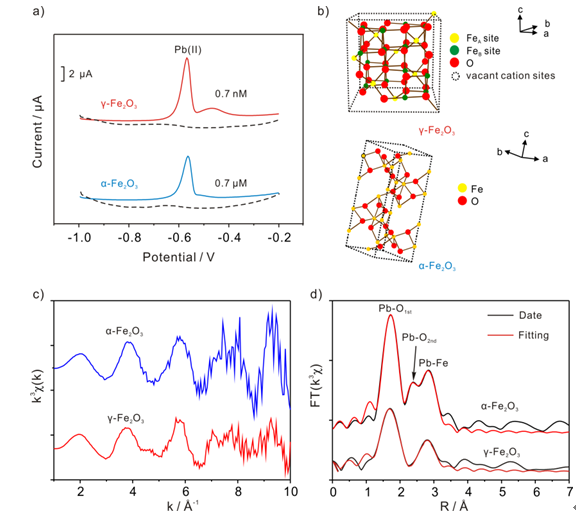Metal oxide micro/nano structure materials with excellent properties, such as catalysis, adsorption and magnetism have attracted considerable scientific interest and have a wide range of application in electrochemical analysis and determination of heavy metal ions. For a long time, the pursuit of high sensitivity and low detection limit is the goal of electrochemical analysis method study. However, the enhancement mechanism based on the atomic level of nano-materials is still unclear. So the understanding of the intrinsic impact of different crystal phases of nano-materials through the crystal structure will provide the insight into the effect of different crystal phases in electroanalysis, which is beneficial to designing a high efficient sensing interface to determine heavy metal ions.
Recently, scientists from Institutes of Intelligent Machines, Chinese Academy of Sciences (CAS), Prof. LIU Jinhuai who is 973 chief scientist and Prof. HUANG Xingjiu, cooperated with Prof. HUANG Yuying, and Asso. Prof. LI Lina from Shanghai Synchrotron Radiation Facility, Shanghai Institute of Applied Physics, CAS. They revealed the electrochemical analysis mechanism on different crystal phase of nano-Fe2O3 using advancing approach extended X-ray absorption fine structure (EXAFS). The paper about the study has been accepted for publication by Analytical Chemistry (http://pubs.acs.org/journal/ancham).
Researchers studied the influence of different crystalline phases Fe2O3 (α- and γ-Fe2O3) nano-flower on the electrochemical detection of Pb(II). Considering the crystal structure with adsorption capacity and adsorption methods, they revealed the relationship between the electrochemical phenomenon and the crystal structure. The study show Fe2O3 nanoflowers with different crystal phases presented interesting difference in electrochemical stripping behaviors toward Pb(II). The sensitivity on γ-Fe2O3 modified electrode is about three orders of magnitude higher than that of α-Fe2O3 modified electrode (Figure a). An important evidence of X-ray photoelectron spectroscopy (XPS) and EXAFS are used to verify the difference in local structural environment of the adsorbed Pb(II) on the surface of α- and γ-Fe2O3. XPS results show that the surface of γ-Fe2O3 is covered with more hydroxyl groups due to the existence of vacant cation sites (Fig. a) which usually occurs in octahedral positions and is recognized as one of the crystal defect. These surface hydroxyl groups on the iron oxides can exchange with Pb(II) to form surface complexes resulting in the higher adsorption capacity of Pb(II) than α-Fe2O3. Furthermore, EXAFS clearly indicates that α- and γ-Fe2O3 have diverse interaction between Pb(II) and iron (hydr)oxides. Pb(II) ions adsorbed on the surface of α-Fe2O3 are bonded as Pb-OH and Pb-H2O while only Pb-OH on γ-Fe2O3(Figure c and d). This study offers a clearer understanding on sensitive electroanalysis using micromaterials modified electrode , compared to the state-of-the-art electrochemical methods for detection of heavy metal ions. It is anticipated that it will be possible to design a high efficient sensing interface to determine other heavy metal ions (not only Pb(II)) by choosing different crystal structures.
Article link: http://pubs.acs.org/doi/abs/10.1021/acs.analchem.5b03570 (Analytical Chemistry, 2015. DOI: 10.1021/acs.analchem.5b03570).
Iron Oxide with Different Crystal Phases (α- and γ-Fe2O3) in Electroanalysis and Ultra-Sensitive and Selective Detection of Lead(II): An Advancing Approach Using XPS and EXAFS
Key words: Fe2O3; crystal phases; EXAFS; Pb(II)
Prof. HUANG Xing-Jiu, Ph.D Principal Investigator
Nanomaterials and Environmental Detection Laboratory, Institutes of Intelligent Machines, Chinese Academy of Sciences, Hefei 230031
E-mail: xingjiuhuang@iim.ac.cn (X.J.H)
Tel.: +86-551-65591142; fax: +86-551-65592420

Figure. a) Typical SWASV responses of Pb(II) on α-Fe2O3 and γ-Fe2O3 modified GCE (glassy carbon electrode) at different concentrations. b) Graphical representations of the fundamental crystal of α-Fe2O3 and γ-Fe2O3. c) Normalized, k3-weighted Pb LIII-XAFS spectra of the Pb(II)/α-Fe2O3 and γ-Fe2O3. d) Fourier transforms (FTs) of EXAFS data with fits to spectra uncorrected for phase shift. (Image by LI Shan-Shan)
